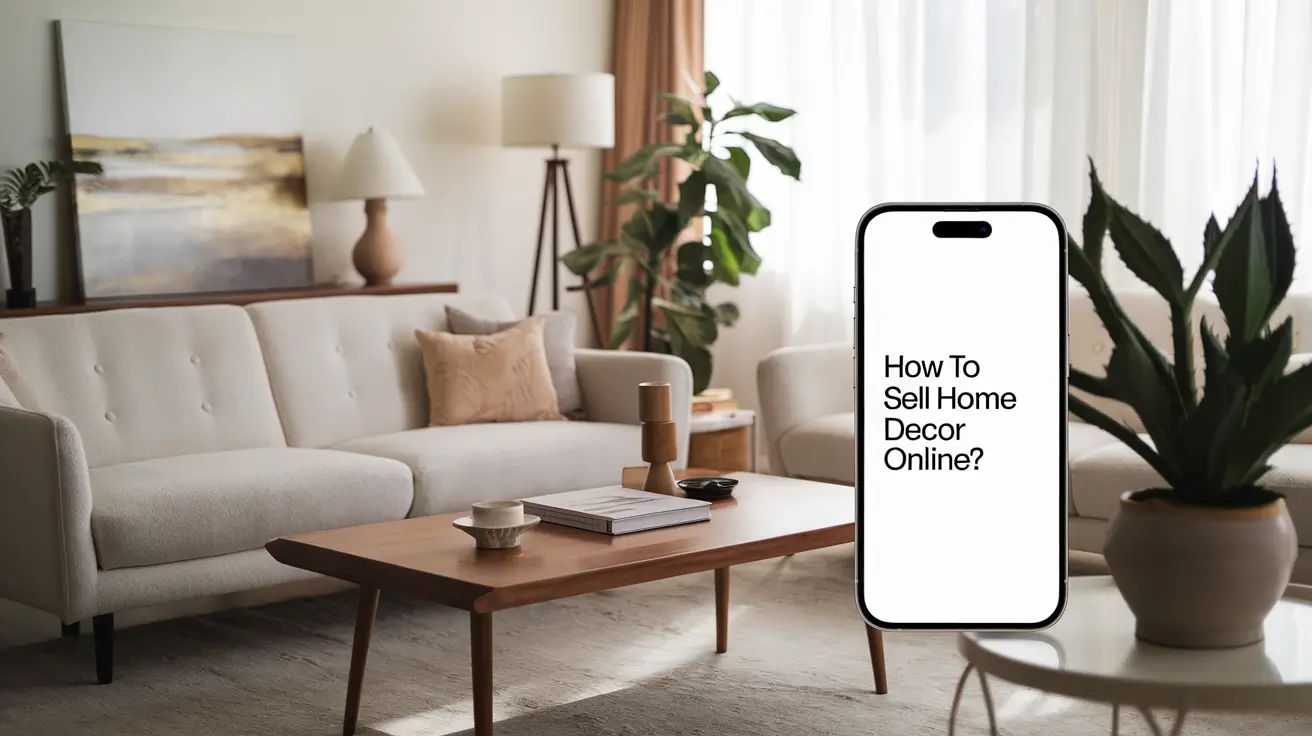How to Sell Home Decor Online? 3 Amazing Ways To Sourece Home Decor
The home decor industry has become a thriving market as people increasingly focus on making their living spaces aesthetically pleasing, comfortable, and stylish. If you’re looking to capitalize on this trend, learning how to sell home decor online offers an exciting opportunity. Whether you’re passionate about designing unique decor items, curating trendy pieces, or building a brand that reflects your personal style, selling home decor online can be both lucrative and rewarding. Success in the online marketplace, however, requires a well-thought-out strategy—from selecting the right products and platforms to crafting effective marketing campaigns that resonate with your target audience.
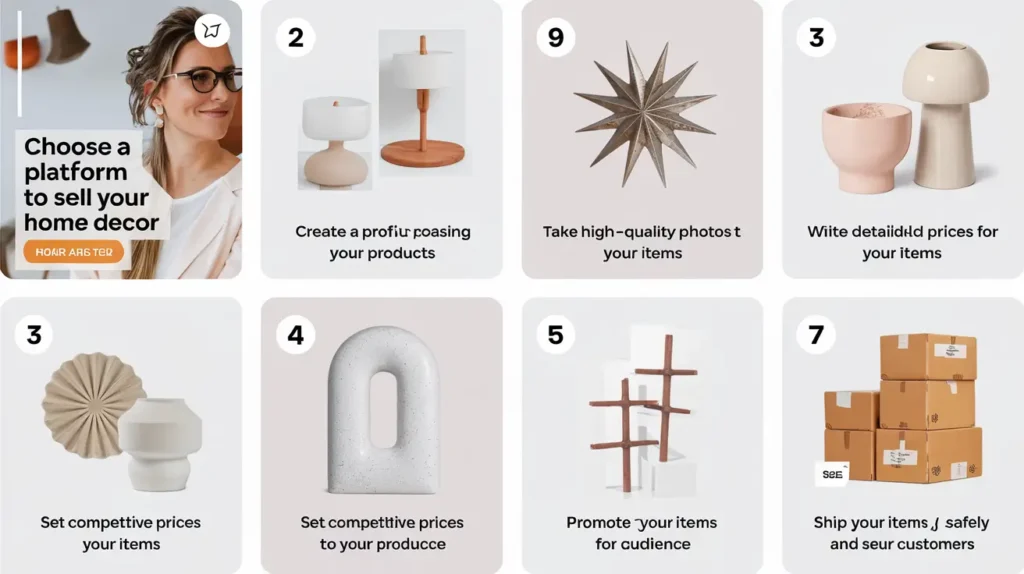
In this comprehensive guide, we’ll walk you through how to sell home decor online successfully, helping you build a profitable and sustainable e-commerce business.
Table of Contents
- Researching the Home Decor Market
- Sourcing Home Decor Products
- Setting Up Your Online Home Decor Store
- Marketing Your Home Decor Business Online
- Building Customer Loyalty and Trust
- Overcoming Challenges When Selling Home Decor Online
- Expanding Your Reach and Scaling Your Business
- Analyzing Performance and Making Data-Driven Improvements
- Staying Ahead of Industry Trends
- Is Selling Home Decor Online Profitable?
- What is the Profit Margin on Home Decor?
- Where to Sell Home Decor Near Me
- Also Read: The Intersection of Technology and Home Decor
- How to Sell Home Decor Online for Cash
- Where to Sell Used Home Decor
- How to Sell Home Products Online
- 10 Tips for How to Sell Home Decor Online
- A Proven Strategy to Successfully Sell Home Decor
- Conclusion: Sell Home Decor Online
- FAQs About Selling Home Decor Online
- What is the first step to selling home decor online?
- Which e-commerce platform is best for selling home decor?
- Do I need a business license to sell home decor online?
- How can I find a reliable supplier for home decor items?
- How can I promote my home decor store online?
- What pricing strategy should I use for my products?
- Should I offer customization options for my home decor products?
- How do I handle shipping for my home decor business?
- What are the best marketing channels for selling home decor?
- How can I ensure repeat business from customers?
- What types of home decor products sell best online?
- Should I sell my products internationally?
- How do I optimize my home decor website for search engines?
- What tools can help manage inventory and sales?
- Can I succeed in a crowded home decor market?
- Is it better to manufacture or dropship home decor products?
Researching the Home Decor Market
a. Analyzing Industry Trends and Consumer Demand
Understanding current home decor trends and consumer preferences is essential when learning how to sell home decor online. This subheading covers:
- Top design trends, such as minimalism, rustic-chic, or mid-century modern
- Identifying high-demand products like wall art, decorative pillows, and lighting fixtures
- Using tools like Google Trends, Pinterest, and industry reports to analyze market demand
b. Identifying Your Niche in the Home Decor Market
To stand out in a competitive marketplace, you must define your niche. Consider narrowing your focus to a specific style, material, theme, or target audience. This could involve specializing in eco-friendly decor, vintage pieces, or modern art-inspired items. Your niche should reflect your brand’s unique selling point (USP) and appeal to a clearly defined group of customers.
Sourcing Home Decor Products
a. Creating Your Own Home Decor Products
If you have a talent for crafting or designing, creating your own products can set your brand apart. In this section, we discuss:
- How to design unique home decor pieces that resonate with your audience
- Sourcing raw materials and managing production efficiently
- Pricing your handcrafted items to ensure profitability
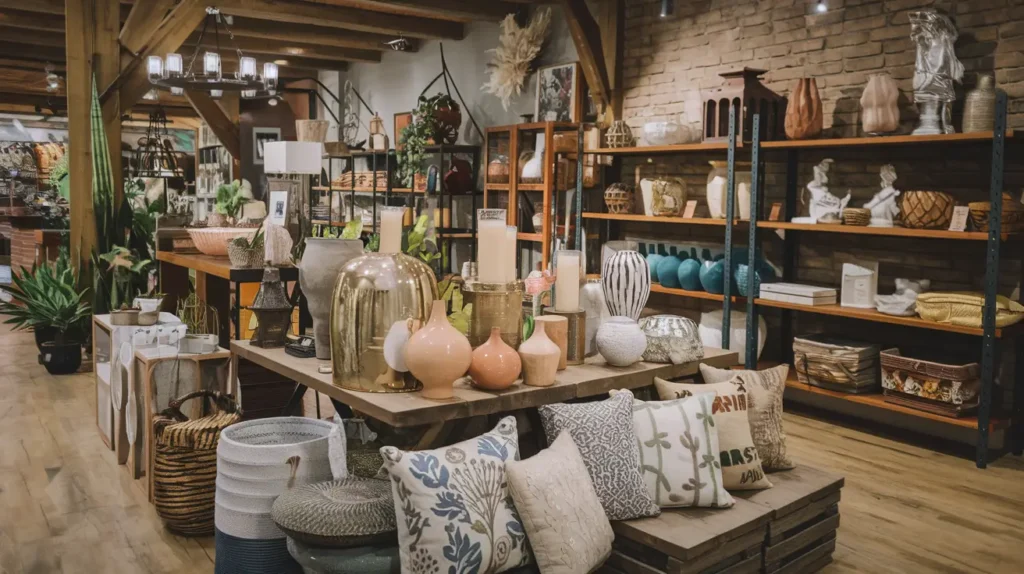
b. Finding Reliable Suppliers and Manufacturers
If you prefer reselling or wholesaling home decor items, finding quality suppliers is key. Explore:
- Tips for selecting trustworthy manufacturers and suppliers
- Negotiating pricing, minimum order quantities, and shipping terms
- Verifying the quality of products and building strong relationships with suppliers
c. Dropshipping Home Decor Products
Dropshipping allows you to sell home decor items without holding inventory. This business model minimizes upfront investment and simplifies logistics. Learn:
- How to find reputable dropshipping partners
- Advantages and potential downsides of dropshipping home decor
- Integrating dropshipping with your online store
Setting Up Your Online Home Decor Store
a. Choosing the Right E-Commerce Platform
When selling home decor online, the platform you choose can significantly impact your success. Consider popular options like Shopify, WooCommerce, or Etsy, each offering unique advantages. Evaluate factors such as ease of use, customizability, and pricing plans.
b. Building an Attractive and User-Friendly Website
A visually appealing, user-friendly website is crucial for selling home decor online. This subheading offers tips on:
- Designing a cohesive and visually stunning storefront that reflects your brand
- Optimizing product listings with high-quality images, detailed descriptions, and pricing
- Enhancing the customer experience with intuitive navigation, mobile responsiveness, and fast loading times

c. Adding Product Listings with Compelling Descriptions
Accurate and engaging product descriptions are essential for converting visitors into customers. Highlight key features, dimensions, materials, and unique selling points. Include relevant keywords for SEO optimization to attract organic traffic.
d. Offering Multiple Payment Options and Secure Checkout
Make it easy for customers to complete their purchase by offering a variety of payment methods, including credit cards, digital wallets, and buy-now-pay-later options. Ensure your checkout process is secure and complies with data protection standards.
Marketing Your Home Decor Business Online
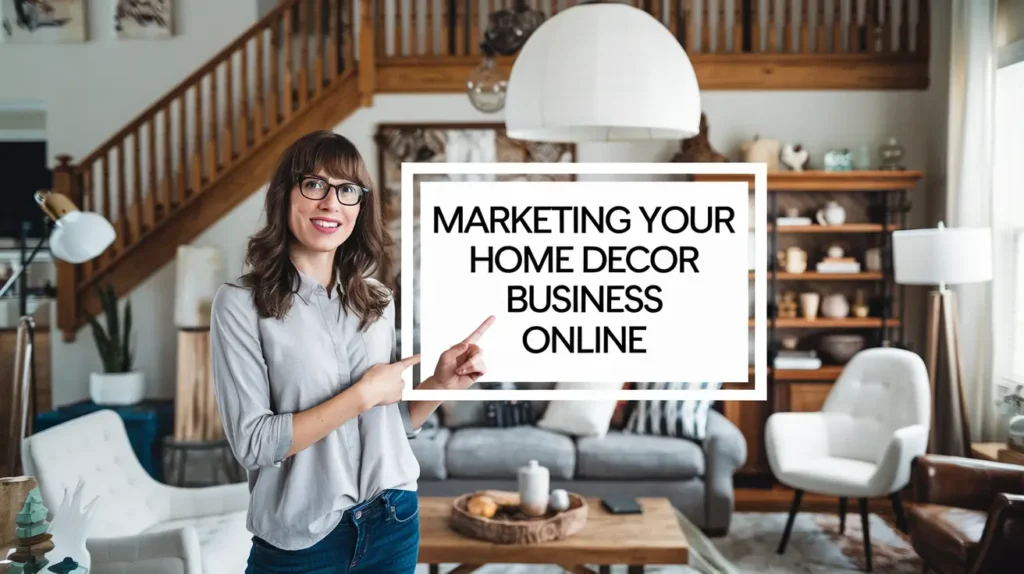
a. Creating a Strong Brand Identity
A recognizable brand helps you stand out in the home decor market. Focus on:
- Developing a memorable brand logo, tagline, and color scheme
- Defining your brand values and communicating them consistently
- Building an emotional connection with your target audience
b. Leveraging Social Media Marketing
Social media platforms like Instagram, Pinterest, and Facebook are ideal for showcasing home decor items. Tips for success include:
- Creating visually appealing content, including lifestyle images and video tours
- Using hashtags, influencers, and user-generated content to expand reach
- Running targeted ad campaigns to attract potential customers
c. Optimizing Your Online Store for SEO
Search engine optimization (SEO) is essential for increasing organic traffic to your online store. This subheading covers:
- Conducting keyword research to find relevant terms like “modern home decor” or “boho wall art”
- Optimizing product pages, meta descriptions, and image alt text for SEO
- Building backlinks and creating valuable content through a blog or resource center
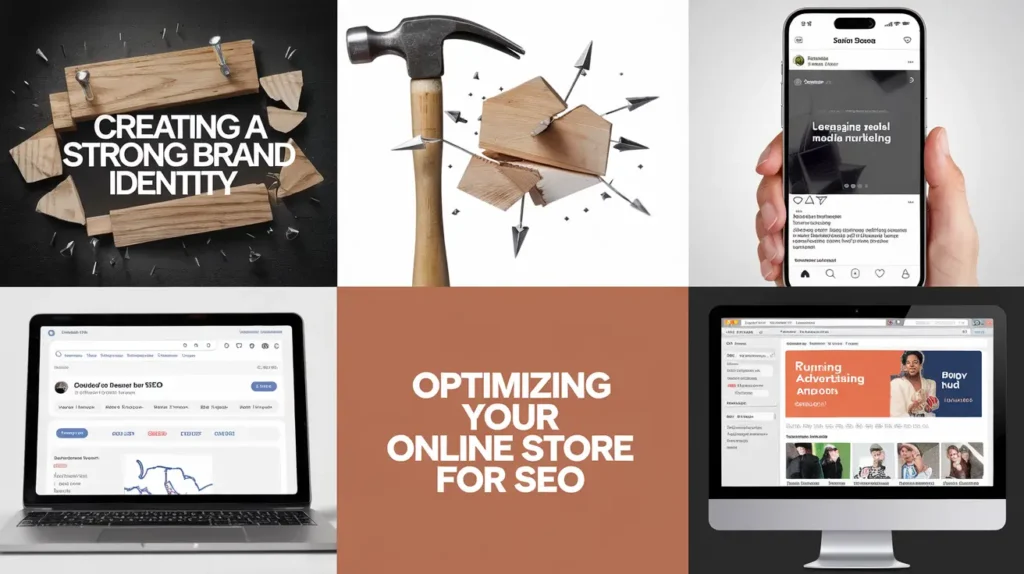
d. Running Paid Advertising Campaigns
Investing in paid ads can boost your online visibility quickly. Consider using platforms like Google Ads, Facebook Ads, and Pinterest Ads. Learn:
- How to create effective ad copy and visuals that drive sales
- Targeting the right demographics and interests
- Measuring and optimizing your ad campaigns
Managing Inventory, Shipping, and Fulfillment
a. Efficient Inventory Management
Managing inventory effectively ensures you always have popular products in stock while avoiding overstock issues. Tips include:
Using inventory management software to track stock levels
Identifying trends to predict demand and avoid stockouts
Offering pre-orders or limited-edition products to create demand
b. Choosing the Best Shipping and Fulfillment Strategy
Fast, reliable shipping is a key factor in customer satisfaction. Explore options such as:
Using third-party fulfillment centers or handling fulfillment in-house
Offering multiple shipping methods and transparent pricing
Providing order tracking and clear delivery times
Building Customer Loyalty and Trust
a. Providing Excellent Customer Service
High-quality customer support can differentiate your brand from competitors. Consider:
- Responding promptly to customer inquiries and addressing concerns
- Implementing hassle-free returns and exchanges
- Encouraging feedback and using it to improve your offerings
b. Encouraging Reviews and Testimonials
Positive customer reviews and testimonials can boost trust and credibility. Encourage satisfied customers to leave reviews through follow-up emails, incentives, or social media shoutouts.
c. Creating a Loyalty Program
Loyalty programs can increase repeat purchases. Offer rewards such as discounts, free shipping, or exclusive access to new collections.
Overcoming Challenges When Selling Home Decor Online
a. Standing Out in a Crowded Market
To compete effectively, differentiate your brand through unique products, exceptional customer service, or a memorable brand story. This subheading explores strategies to rise above competitors.
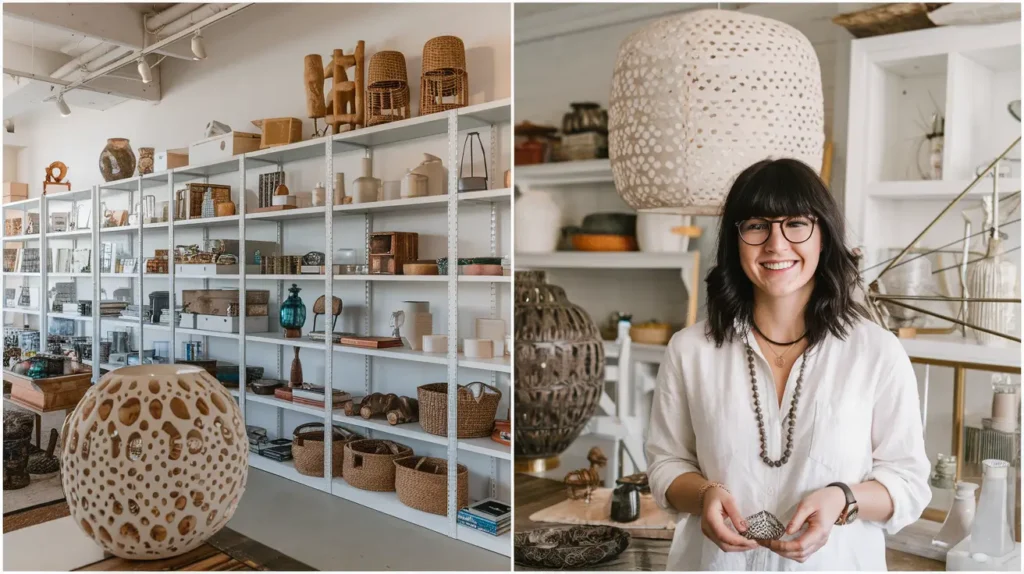
b. Handling Returns and Product Damage
Returns and damaged items can cut into your profits. Mitigate these risks by using secure packaging, offering clear product descriptions, and having a fair return policy.
Expanding Your Reach and Scaling Your Business

a. Collaborating with Influencers and Bloggers
Partnering with influencers and home decor bloggers can significantly increase your brand’s visibility and credibility. Influencers have established audiences who trust their opinions and recommendations. Here’s how to effectively collaborate:
- Identify influencers whose aesthetics and target audiences align with your brand.
- Reach out with personalized pitches highlighting the value of a partnership.
- Create campaigns where influencers showcase your products in their homes, provide decorating tips, or host giveaways.
- Leverage user-generated content to add authenticity and social proof to your online store.
b. Offering Customization and Personalization Options
Home decor buyers often seek items that reflect their personal tastes and preferences. By offering customization options such as personalized engravings, fabric choices, or made-to-order items, you can differentiate your brand and provide added value. Highlighting these options can boost customer engagement and encourage repeat purchases.
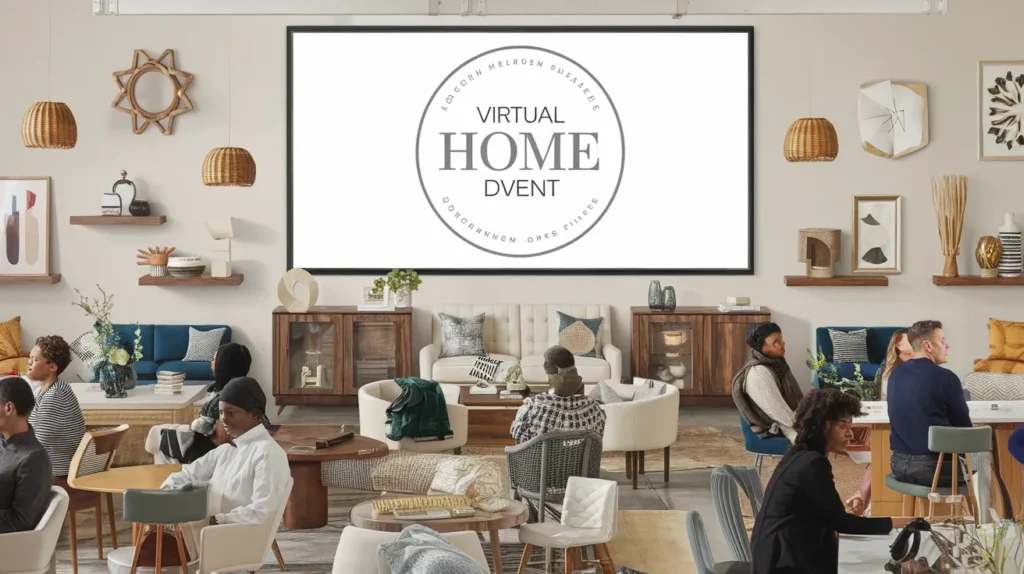
c. Expanding to Additional Sales Channels
Consider diversifying your sales channels to increase brand exposure. Selling exclusively on your e-commerce website is one option, but many successful businesses also list on popular marketplaces such as Amazon, Etsy, and Wayfair. This approach can help reach a broader customer base and introduce new revenue streams. Each channel may require adaptation of your sales strategy to align with marketplace-specific rules and customer expectations.
d. Hosting Virtual Home Decor Events
Organize virtual events, such as live product showcases, virtual interior design consultations, or home styling workshops. These events allow you to demonstrate your expertise, build community engagement, and offer exclusive discounts or product launches. Live-streaming on social media platforms or conducting Zoom workshops are effective ways to reach a global audience.
Analyzing Performance and Making Data-Driven Improvements
a. Tracking Key Performance Indicators (KPIs)
To grow your online home decor business, you need to monitor key metrics that reflect your performance and guide your strategic decisions. Common KPIs include:
- Sales conversion rate: The percentage of website visitors who make a purchase.
- Average order value (AOV): The average amount spent per order.
- Customer acquisition cost (CAC): The cost to acquire a new customer through marketing and advertising.
- Customer lifetime value (CLV): The total revenue generated from a customer over the duration of their relationship with your brand.
By tracking these metrics, you can identify areas for improvement, optimize your marketing efforts, and maximize profitability.
b. Analyzing Customer Feedback
Customer reviews, feedback surveys, and social media interactions offer invaluable insights into what your audience loves and where you can improve. Actively listening to your customers helps you refine product offerings, improve customer service, and build a loyal community.
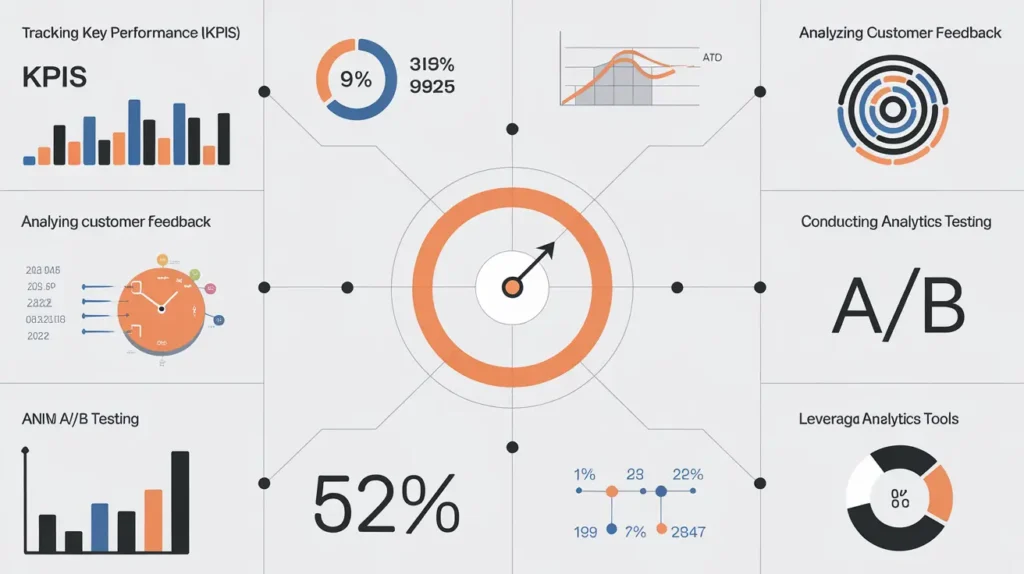
c. Conducting A/B Testing
Experimentation is essential for optimizing your online store’s performance. Conduct A/B tests on different elements, such as product images, pricing, call-to-action buttons, and promotions. Analyze the results to determine what resonates best with your target audience and drives conversions.
d. Leveraging Analytics Tools
Use tools like Google Analytics, social media analytics, and e-commerce platform dashboards to track user behavior, website traffic, and conversion rates. Detailed analytics empower you to make data-driven decisions and implement improvements for growth.
Staying Ahead of Industry Trends
a. Attending Trade Shows and Networking Events
Stay informed about emerging home decor trends by attending industry trade shows, design expos, and online networking events. These events are excellent opportunities to discover new products, connect with suppliers, and gain insights into future customer preferences.
b. Staying Agile and Adapting to Changes
The home decor market is dynamic, with tastes, trends, and consumer behavior shifting frequently. Stay adaptable by continuously evaluating your product line, marketing strategies, and customer feedback. Being willing to pivot quickly allows you to remain relevant in a competitive market.

c. Incorporating Eco-Friendly and Sustainable Practices
Sustainability is a growing trend in the home decor industry, and environmentally conscious customers seek products that align with their values. Consider using eco-friendly materials, reducing packaging waste, and highlighting sustainable practices in your marketing. Transparent communication about your commitment to sustainability can attract eco-conscious buyers.
d. Enhancing Customer Experience with AR/VR Technology
Leverage augmented reality (AR) and virtual reality (VR) tools to offer customers immersive experiences, such as virtually placing decor items in their homes. This technology can reduce hesitation, increase confidence in purchasing decisions, and set your business apart from competitors.
Is Selling Home Decor Online Profitable?
Yes, selling home decor online can be profitable, especially with the rise of e-commerce platforms and an increasing demand for unique and customizable home goods. However, success depends on factors like product quality, branding, pricing, marketing, and choosing the right platforms. If you can tap into trends, offer high-quality products, and effectively market them, selling home decor online can be a lucrative business.
To be profitable, you’ll need to:
- Identify your niche (e.g., vintage decor, minimalist, boho, eco-friendly).
- Use digital marketing to reach potential customers.
- Offer competitive pricing while keeping your profit margins healthy.
How to Make Money in Home Decor
Making money in home decor involves a few key strategies:
Create Unique Products: Whether you’re making your own designs or curating collections, offering something unique can set you apart.
Sell on Multiple Platforms: Expand your reach by selling on e-commerce platforms, marketplaces, and even social media.
Leverage Social Media: Use Instagram, Pinterest, and TikTok to showcase your products, build brand awareness, and drive traffic to your store.
Offer Customization: Personalized home decor items are popular and can command higher prices.
Use Effective Pricing: Balance quality with competitive pricing. Understand your cost of goods sold (COGS) and set a price that ensures a good profit margin.
What is the Profit Margin on Home Decor?
The profit margin on home decor can vary depending on factors such as:
- Product Type: Handmade or custom items may have higher margins compared to mass-produced ones.
- Branding: High-end brands can charge a premium.
- Platform Fees: Selling through platforms like Amazon or Etsy may involve commission fees, affecting your profit.
On average, profit margins for home decor range from 20% to 50%, but this can go higher for unique, high-quality, or luxury items. To calculate your margin:
- Cost of Goods Sold (COGS): How much you spend on sourcing or creating your decor items.
- Selling Price: The price you charge your customers.
- Profit Margin = [(Selling Price – COGS) / Selling Price] x 100.
Does Home Decor Sell Well on Amazon?
Yes, home decor sells well on Amazon due to its massive customer base and established e-commerce infrastructure. Amazon is one of the largest online retailers in the world, and many customers visit the platform specifically for home and lifestyle products. However, competition is fierce, so success on Amazon requires:
Effective keyword optimization for product listings.
Attractive pricing and quality images.
Good reviews and customer satisfaction.
Advertising: Amazon’s PPC (pay-per-click) campaigns can boost visibility.
Additionally, Amazon charges fees (including listing fees and commissions), which can impact your profit margins, so it’s important to factor that in when pricing your products.
Where to Sell Home Decor Near Me
If you’re looking to sell home decor locally, here are some great options:
- Local Farmers’ Markets or Craft Fairs: These venues can attract customers who are interested in handmade or locally sourced home decor.
- Consignment Shops or Boutiques: Partner with local shops that specialize in home decor to sell your products.
- Pop-up Shops: Consider setting up temporary storefronts in high-traffic areas or local events.
- Facebook Marketplace: A great place to sell locally and connect with nearby buyers.
- Craigslist: Although not as popular as it used to be, Craigslist can still be effective for selling home decor items locally.
Also Read: The Intersection of Technology and Home Decor
How to Sell Home Decor Online for Cash
Selling home decor online for cash requires choosing the right platform and focusing on inventory that appeals to buyers. Here’s how:
- Etsy: Great for handmade, vintage, or unique home decor items.
- eBay: Ideal for both new and used home decor, particularly if you can auction items.
- Facebook Marketplace: Allows you to sell to local buyers quickly and easily for cash.
- Poshmark: Though it’s mainly known for fashion, Poshmark also allows sellers to list home decor and accessories.
- OfferUp: Another marketplace that lets you sell locally and get cash quickly.
Be sure to have quality photos and detailed descriptions to attract potential buyers.
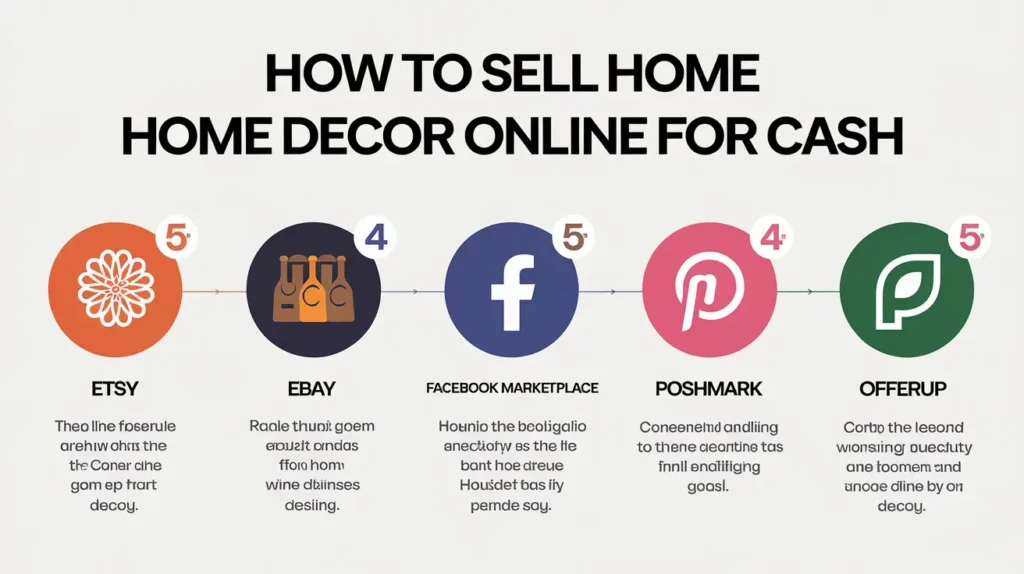
Where to Sell Used Home Decor
If you’re looking to sell used home decor, there are several options:
- Facebook Marketplace: Great for selling used furniture, decor, or art locally.
- Craigslist: Still an effective platform for local, used items.
- OfferUp: Like Facebook Marketplace, OfferUp is geared toward local sales.
- eBay: For vintage or collectible home decor items, eBay can provide a global marketplace.
- Thrift Stores and Consignment Shops: Some consignment shops will take in used home decor to sell on your behalf.
- Garage Sales: Hosting a local garage sale is an easy way to declutter and sell items fast.
Etsy
Etsy is one of the most popular online marketplaces for handmade, vintage, and unique home decor. It’s ideal for those selling customized or one-of-a-kind pieces. Setting up a shop on Etsy is easy, and you’ll benefit from the platform’s established audience of shoppers interested in home goods. However, Etsy charges fees for listing products and takes a small percentage of each sale.
Shopify
Shopify is an e-commerce platform where you can create your own branded online store. It allows you to sell home decor products directly to customers with full control over the design, sales process, and marketing. Shopify is best for those who want to build their own brand and have more control over their store’s operations. It has monthly fees, but it provides an array of tools for marketing, customer management, and analytics.
eBay
eBay is another great platform for selling home decor, especially for used, vintage, or collectible items. You can auction items or sell them at a fixed price, giving you flexibility. The eBay community is vast, which means there’s a large potential audience. However, eBay takes a small commission for each sale, so be sure to factor that into your pricing.
How to Sell Home Products Online
Selling home products online involves creating an online presence and utilizing e-commerce platforms. Here’s how:
- Choose Your Platform: Decide where you want to sell (e.g., Etsy, Shopify, Amazon, eBay).
- Create a Brand: Develop a recognizable brand that appeals to your target audience (e.g., rustic farmhouse, modern minimalism).
- Build an Online Store: Use platforms like Shopify or Etsy to create a professional-looking online store. For Shopify, you’ll need to design the website and set up payment methods.
- Marketing: Use social media platforms (Instagram, Pinterest) and Google ads to promote your products.
- Customer Service: Respond promptly to customer inquiries, offer great customer service, and encourage positive reviews.

Home Decor Marketplace
A Home Decor Marketplace is a platform specifically dedicated to home products, such as Wayfair, Houzz, or Overstock. These marketplaces are highly focused on home goods and can drive a lot of traffic to your listings. Keep in mind that they usually charge fees and require meeting certain criteria, like a minimum product quantity or quality standards.
10 Tips for How to Sell Home Decor Online
- Understand Your Audience: Know who your customers are and what style of home decor they’re looking for.
- Focus on High-Quality Photos: Clear, well-lit images are crucial to attracting buyers.
- Use SEO for Listings: Optimize your product descriptions with relevant keywords.
- Offer Free Shipping: Free shipping can attract more buyers and increase sales.
- Leverage Social Media: Build a strong social media presence on Instagram, Pinterest, and Facebook to market your products.
- Offer Discounts: Use sales, discounts, and promotions to encourage purchases.
- Create a Unique Brand Identity: Differentiate your products with unique designs or features.
- Provide Excellent Customer Service: Be responsive to inquiries and offer prompt delivery.
- Offer Customization: Personalized decor often sells for a premium.
- Stay Updated on Trends: Keep up with home decor trends to stay competitive.
A Proven Strategy to Successfully Sell Home Decor
- Find Your Niche: Specialize in a particular style (e.g., boho, modern, vintage) to attract a targeted audience.
- Create High-Quality Products: Ensure your decor items are well-made, durable, and appealing.
- Optimize Your Online Store: Have an easy-to-navigate website, clear product descriptions, and a smooth checkout process.
- Use Paid Advertising: Invest in ads on Google, Instagram, or Facebook to increase visibility.
- Build Relationships with Influencers: Partner with interior design influencers to promote your products.
Conclusion: Sell Home Decor Online
Selling home decor online requires a thoughtful blend of creativity, strategy, and a deep understanding of your target audience. From researching market trends and finding quality products to building a strong online presence and offering personalized customer experiences, every aspect contributes to your brand’s success. By implementing effective marketing strategies, maintaining customer-centric operations, and embracing innovation, you can create a thriving home decor business that resonates with customers and adapts to evolving market demands.
Whether you’re a seasoned entrepreneur or a newcomer to e-commerce, knowing how to sell home decor online allows you to tap into a profitable industry and bring your vision to life. Take the first steps confidently, and remember to keep learning and evolving. With dedication and passion, your home decor brand can become a cherished destination for customers looking to transform their living spaces.
FAQs About Selling Home Decor Online
What is the first step to selling home decor online?
A1: The first step to selling home decor online is to research and identify a niche within the market. Consider your target audience, current trends, and what makes your products stand out. Once you’ve chosen a niche, you can source or create products and select the appropriate platform to launch your online store.
Which e-commerce platform is best for selling home decor?
A2: The best platform depends on your business needs, budget, and sales strategy. Shopify, WooCommerce, Etsy, and Amazon are popular choices for selling home decor online. Shopify is user-friendly and customizable, WooCommerce is great for WordPress users, Etsy is ideal for handcrafted items, and Amazon offers access to a vast customer base.
Do I need a business license to sell home decor online?
A3: The requirement for a business license depends on your location and local regulations. In most cases, you may need a license if you operate as a business, collect sales tax, or sell certain types of products. Check with local authorities to understand licensing requirements for your business.
How can I find a reliable supplier for home decor items?
A4: To find a reliable supplier, start by researching industry directories, attending trade shows, or exploring online platforms like Alibaba. When choosing a supplier, consider factors such as product quality, pricing, minimum order quantities, lead times, and customer reviews. Building a strong relationship with your supplier is essential for success.
How can I promote my home decor store online?
A5: Promote your store by leveraging social media marketing, search engine optimization (SEO), content marketing (e.g., blogs), influencer collaborations, email marketing, and paid advertising campaigns on platforms like Google and Facebook. Engaging visuals, consistent branding, and targeted marketing can effectively attract and retain customers.
What pricing strategy should I use for my products?
A6: Consider factors such as production costs, market demand, competitor pricing, and your target profit margin when pricing your products. You can use strategies like competitive pricing, psychological pricing (e.g., ending prices in $0.99), or bundle offers. Periodic promotions can help boost sales and attract new customers.
Should I offer customization options for my home decor products?
A7: Yes, offering customization can set your brand apart and appeal to customers seeking personalized items. Consider offering options like monogramming, choosing colors or patterns, or made-to-order designs. Highlight these options in your product descriptions to attract more interest.
How do I handle shipping for my home decor business?
A8: Efficient shipping is crucial for customer satisfaction. You can manage fulfillment in-house, work with third-party logistics (3PL) companies, or use dropshipping. Offering multiple shipping methods, providing accurate delivery estimates, and using secure packaging to prevent damage are important considerations.
What are the best marketing channels for selling home decor?
A9: Social media platforms like Instagram and Pinterest are especially effective for home decor due to their visual nature. You can also use Google Ads, email marketing, and blogging to attract traffic to your store. Influencer partnerships and paid collaborations can help you reach broader audiences.
How can I ensure repeat business from customers?
A10: Focus on delivering excellent customer service, high-quality products, and a seamless shopping experience. Implement a loyalty or rewards program, offer personalized recommendations, and use follow-up emails to stay engaged with your customers. Building trust and providing value encourages repeat business.
What types of home decor products sell best online?
A11: Popular categories include wall art, decorative pillows, furniture, rugs, lighting, planters, and seasonal decorations. Trends change over time, so stay informed about consumer preferences and market demand to adapt your product offerings accordingly.
Should I sell my products internationally?
A12: Expanding internationally can be beneficial but requires additional considerations such as international shipping costs, customs regulations, and localization of product descriptions. If your products have a broad appeal and you have the resources to support international orders, this can be a valuable growth opportunity.
How do I optimize my home decor website for search engines?
A13: Start with keyword research to identify terms your target audience is searching for, then incorporate those keywords into your product titles, descriptions, meta tags, and image alt text. Regularly publish high-quality content (e.g., blogs) related to home decor trends to attract organic traffic.
What tools can help manage inventory and sales?
A14: Inventory management tools like TradeGecko, Odoo, or integrated software within e-commerce platforms can help you track stock levels, forecast demand, and manage reordering. Sales analytics tools help you understand performance trends and make data-driven decisions.
Can I succeed in a crowded home decor market?
A15: Yes, success in a competitive market depends on differentiation, effective marketing, and understanding your audience’s needs. Focus on offering unique, high-quality products and providing exceptional customer service. Building a strong brand identity and staying agile in response to trends also contribute to long-term success.
Is it better to manufacture or dropship home decor products?
A16: Manufacturing allows for greater control over quality and branding but requires upfront investment and inventory management. Dropshipping minimizes inventory costs but may reduce profit margins and require careful vetting of suppliers. Choose based on your business goals and resources.

